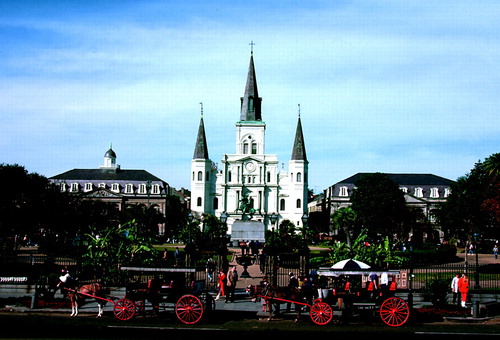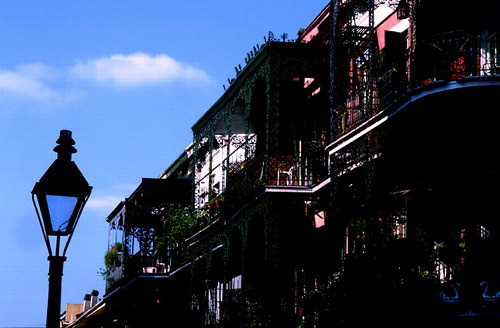Many of New Orleans’ Riches Lie Beyond French Quarter
 The New Orleans most visitors see near their hotels is so interesting that relatively few explore the bigger city where most local residents live. Since most attendees at the annual meeting will be staying near, if not in, the French Quarter, the magnetism of the Quarter is likely to keep them occupied for days. But venturing out into other neighborhoods of New Orleans is a wonderfully rewarding plunge into this fascinating city. So, we’ll start with the familiar and then pull you along on a trip through “The Other New Orleans.”
The New Orleans most visitors see near their hotels is so interesting that relatively few explore the bigger city where most local residents live. Since most attendees at the annual meeting will be staying near, if not in, the French Quarter, the magnetism of the Quarter is likely to keep them occupied for days. But venturing out into other neighborhoods of New Orleans is a wonderfully rewarding plunge into this fascinating city. So, we’ll start with the familiar and then pull you along on a trip through “The Other New Orleans.”
Guidebooks and maps abound with details about the French Quarter, so get one and enjoy. You really don’t need a book, of course, to enjoy some of the oldest architecture in New Orleans, hundreds of art and antique shops, drinking spots, Bourbon Street, more wrought iron than you dreamed existed, and street life that will amaze you. Check out the Historic New Orleans Collection at 533 Royal Street for a good overview of the city’s culture and history, and then step away from the Quarter for a look around the city.
First, a bit of orientation (a map would be helpful). New Orleans is almost completely surrounded by water, with Lake Pontchartrain to the north and the Gulf of Mexico and Mississippi River to the south, although the river’s curves mean that it’s sometimes also to the east and west. (You really do need a map!) While the city was laid out on a grid, most of its long streets (St. Charles Avenue and Magazine Street, for example) follow the curves of the river. This takes some getting used to, because as you walk or ride, you may think you are traveling in a straight line, but you may not be.
Adjoining the Quarter on the east and worth a look (in the company of others) is a neighborhood enjoying a renewal, Faubourg Marigny. Fine homes and a distinct Bohemian atmosphere are there for the appreciation.
Trip to Algiers
That land you see looking across the Mississippi River from the French Quarter is also New Orleans, an area called Algiers. You can make a quick trip over via a free ferry from the foot of Canal Street. Although the homes don’t quite match those on the other side of the river, there are some fine places to see. A real plus about the ferry ride is the view you get—a panorama of the city along the Mississippi. You will see why it’s nicknamed the Crescent City.
If you’re really going to see other neighborhoods outside the immediate annual meeting area, the best start is to hop on the St. Charles Avenue streetcar at the corner of Canal and Carondelet streets. Convenient to most hotels, the streetcar will give you a 13-mile ride along the city’s finest street. You’ll need exact change ($1.25 in bills or coins each way). The St. Charles streetcar line is the oldest continually running city system in the world, and you’ll believe that when you sit on the streetcar’s wood seats. But with this Spartan comfort, you’ll get a glorious ride. (By the way, don’t spend any time looking for the streetcar named Desire. It’s now a bus, and you can see it running down Decatur Street as it passes Jackson Square.)
Once on the streetcar, you’ll quickly leave the Central Business District, which hovers around Poydras Street, and move along the edge of the Warehouse District as your streetcar rounds Lee Circle. Formerly a site of light industry, the area, centered on Julia Street, now flourishes with art shops, crafts studios, museums (including the National D-Day Museum, opened in 1999), coffee shops, and the like.
Following the Muses
New Orleans has some fascinating street names, and as you begin to see streets named for the Greek Muses—Terpsichore, Calliope, Melpomene, Clio, Urania, Erato—you’ll know you’re in the Lower Garden District. (Try pronouncing the street names; whatever you say will be wrong by local standards.) This is a partly funky, partly grand, place, with interesting cafes and shops, and the beginning of shops along Magazine Street.
Beginning where the streetcar crosses Jackson Avenue, the famed Garden District runs along to your left, extending to Louisiana Avenue. Many of the city’s finest homes and gardens are here, as well as one of the city’s aboveground cemeteries. But resist the temptation to get off the streetcar until your return trip, because you’re going to see some glorious houses as you continue into the Uptown area. (When you return to visit the Garden District, a good exit stop is in front of the Episcopal Cathedral, Christ Church, at St. Charles Avenue and Sixth Street.)
Uptown more or less runs along St. Charles Avenue after Louisiana Avenue, and all around you, especially after you cross Napoleon Avenue, are magnificent houses behind canopies of live oak trees. An eclectic mix of grand, fine, and more modest homes, as well as hospitals and churches, mark the Touro-Bouligny area. As the streetcar inches along (they can be a bit slow, but what’s the hurry anyway?), you’ll pass into the University area, with Loyola University and Tulane University and, across the avenue, the 127-acre Audubon Park. With fountains, trails, a golf course, and jogging and walking areas, this is a place for a long stroll among live oaks dripping with Spanish moss. It also has an excellent zoo, and the kids and you will be amazed to see not just a plain alligator, but a white alligator.
Just a little further and the streetcar makes a sharp right turn off St. Charles Avenue onto Carrollton. This is the Riverbend neighborhood, and it means what it says, because you are very close to the Mississippi River at this point, and it bends here. Look up to the left as the streetcar turns, and you’ll find a hill that’s more than a hill. It’s a levee, and it and other levees are there to protect New Orleans from floods. You can get off and climb the levee for a look at the river, but the best place to do that is at Audubon Park on your return trip.

Riverbend is a neat place for refreshments, with interesting cafes and shopping extending for a number of blocks. The streetcar rumbles along into the Carrollton neighborhood, formerly a town itself, but now annexed by New Orleans. Graceful trees line the streets as you pass stately older homes, some in the grand New Orleans style and others more restrained. Finally, you come to the end of the streetcar line at Claiborne Avenue. There is little to see at the end of the line, so most people get off earlier around Riverbend and wait for a return streetcar there. If you stick it out to the end, you’ll note that there is no “turn-around” for the streetcar, and so the front of each car becomes the back for the car’s return trip. Those uncomfortable seats you’ve been sitting on are reversible, and so back you go to Canal Street after paying a return fare.
But don’t be in a hurry to return to downtown. This city is all about letting the good times roll, and good times include getting off the streetcar on the way back and enjoying some of its fine neighborhoods. ▪
Mr. Gant is the former executive editor of Psychiatric News and now an enthusiastic resident of New Orleans.



